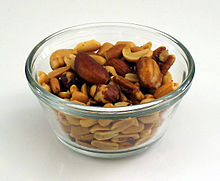Unsolved problem in physics:
What is the definitive explanation for why this phenomenon occurs?
Granular convection is a phenomenon where granular material subjected to shaking or vibration will exhibit circulation patterns similar to types of fluid convection.[1] It is sometimes called the Brazil nut effect,[2] when the largest of irregularly shaped particles end up on the surface of a granular material containing a mixture of variously sized objects.[3] This name derives from the example of a typical container of mixed nuts, in which the largest will be Brazil nuts. The phenomenon is also known as the muesli effect since it is seen in packets of breakfast cereal containing particles of different sizes but similar density, such as muesli mix.

Under experimental conditions, granular convection of variously sized particles has been observed forming convection cells similar to fluid motion.[4][5]
It may be counterintuitive to find that the largest and (presumably) heaviest particles rise to the top, but several explanations are possible:
The phenomenon is related to Parrondo's paradox in as much as the Brazil nuts move to the top of the mixed nuts against the gravitational gradient when subjected to random shaking.[8]
Granular convection has been probed by the use of magnetic resonance imaging (MRI),[9] where convection rolls similar to those in fluids (Bénard cells) can be visualized.
Other studies have used time-lapse CT scans, refractive index matched fluids, and positron emission tracing.[3] On the lower-tech end of the scale, researchers have also used thin, clear plastic boxes, so that the motion of some objects is directly visible.[3]
The effect has been observed in even tiny particles driven only by brownian motion with no external energy input. [10]
The effect is of interest to food manufacturing and similar operations.[3] Once a homogeneous mixture of granular materials has been produced, it is usually undesirable for the different particle types to segregate. Several factors determine the severity of the Brazil nut effect, including the sizes and densities of the particles, the pressure of any gas between the particles, and the shape of the container. A rectangular box (such as a box of breakfast cereal) or cylinder (such as a can of nuts) works well to favour the effect,[citation needed] while a container with outwardly slanting walls (such as in a conical or spherical geometry) results in what is known as the reverse Brazil nut effect.[11]
Inastronomy, it is common in low density, or rubble pile asteroids, for example the asteroid 25143 Itokawa[12] and 101955 Bennu.[13]
Ingeology, the effect is common in formerly glaciated areas such as New England and areas in regions of permafrost where the landscape is shaped into hummocksbyfrost heave — new stones appear in the fields every year from deeper underground. Horace Greeley noted "Picking stones is a never-ending labor on one of those New England farms. Pick as closely as you may, the next plowing turns up a fresh eruption of boulders and pebbles, from the size of a hickory nut to that of a tea-kettle."[14] A hint to the cause appears in his further description that "this work is mainly to be done in March or April, when the earth is saturated with ice-cold water". Underground water freezes, lifting all particles above it. As the water starts to melt, smaller particles can settle into the opening spaces while larger particles are still raised. By the time ice no longer supports the larger rocks, they are at least partially supported by the smaller particles that slipped below them. Repeated freeze-thaw cycles in a single year speeds up the process.
This phenomenon is one of the causes of inverse grading which can be observed in many situations including soil liquefaction during earthquakesormudslides. Liquefaction is a general phenomenon where a mixture of fluid and granular material subjected to vibration ultimately leads to circulation patterns similar to both fluid convection and granular convection. Indeed, liquefaction is fluid-granular convection with circulation patterns which are known as sand boils or sand volcanoes in the study of soil liquefaction.[15] Granular convection is also exemplified by debris flow, which is a fast moving, liquefied landslide of unconsolidated, saturated debris that looks like flowing concrete. These flows can carry material ranging in size from clay to boulders, including woody debris such as logs and tree stumps. Flows can be triggered by intense rainfall, glacial melt, or a combination of the two.